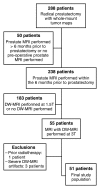Diffusion-weighted endorectal MR imaging at 3 T for prostate cancer: tumor detection and assessment of aggressiveness
- PMID: 21436085
- PMCID: PMC3099046
- DOI: 10.1148/radiol.11102066
Diffusion-weighted endorectal MR imaging at 3 T for prostate cancer: tumor detection and assessment of aggressiveness
Abstract
Purpose: To assess the incremental value of diffusion-weighted (DW) magnetic resonance (MR) imaging over T2-weighted MR imaging at 3 T for prostate cancer detection and to investigate the use of the apparent diffusion coefficient (ADC) to characterize tumor aggressiveness, with whole-mount step-section pathologic analysis as the reference standard.
Materials and methods: The Internal Review Board approved this HIPAA-compliant retrospective study and waived informed consent. Fifty-one patients with prostate cancer (median age, 58 years; range, 46-74 years) underwent T2-weighted MR imaging and DW MR imaging (b values: 0 and 700 sec/mm(2) [n = 20] or 0 and 1000 sec/mm(2) [n = 31]) followed by prostatectomy. The prostate was divided into 12 regions; two readers provided a score for each region according to their level of suspicion for the presence of cancer on a five-point scale, first using T2-weighted MR imaging alone and then using T2-weighted MR imaging and the ADC map in conjunction. Areas under the receiver operating characteristic curve (AUCs) were estimated to evaluate performance. Generalized estimating equations were used to test the ADC difference between benign and malignant prostate regions and the association between ADCs and tumor Gleason scores.
Results: For tumor detection, the AUCs for readers 1 and 2 were 0.79 and 0.76, respectively, for T2-weighted MR imaging and 0.79 and 0.78, respectively, for T2-weighted MR imaging plus the ADC map. Mean ADCs for both cancerous and healthy prostatic regions were lower when DW MR imaging was performed with a b value of 1000 sec/mm(2) rather than 700 sec/mm(2). Regardless of the b value used, there was a significant difference in the mean ADC between malignant and benign prostate regions. A lower mean ADC was significantly associated with a higher tumor Gleason score (mean ADCs of [1.21, 1.10, 0.87, and 0.69] × 10(-3) mm(2)/sec were associated with Gleason score of 3 + 3, 3 + 4, 4 + 3, and 8 or higher, respectively; P = .017).
Conclusion: Combined DW and T2-weighted MR imaging had similar performance to T2-weighted MR imaging alone for tumor detection; however, DW MR imaging provided additional quantitative information that significantly correlated with prostate cancer aggressiveness.
RSNA, 2011
Figures












References
-
- Jemal A, Siegel R, Xu J, Ward E. Cancer statistics, 2010. CA Cancer J Clin 2010;60(5):277–300 - PubMed
-
- Akin O, Hricak H. Imaging of prostate cancer. Radiol Clin North Am 2007;45(1):207–222 - PubMed
-
- Fuchsjäger M, Akin O, Shukla-Dave A, Pucar D, Hricak H. The role of MRI and MRSI in diagnosis, treatment selection, and post-treatment follow-up for prostate cancer. Clin Adv Hematol Oncol 2009;7(3):193–202 - PubMed
Publication types
MeSH terms
Grants and funding
LinkOut - more resources
Full Text Sources
Other Literature Sources
Medical

